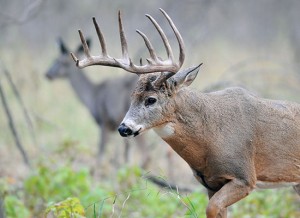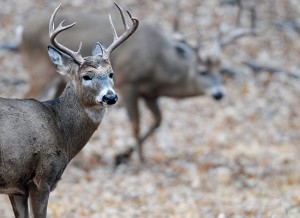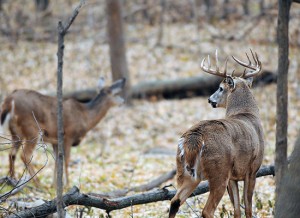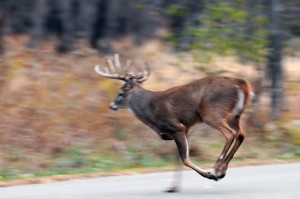September 28, 2012
By Mark Morrison
 If there's one time of year bowhunters anticipate with uncontained enthusiasm, it's the whitetail rut! It's a time when normally reclusive bucks throw caution to the wind and run amuck in search of suitable mates. At least that's what we hope for — a big buck making a lovesick misstep that brings him into range of our bow. Sounds easy, right? Well, not if you haven't done your pre-hunt scouting, and lots of it.
If there's one time of year bowhunters anticipate with uncontained enthusiasm, it's the whitetail rut! It's a time when normally reclusive bucks throw caution to the wind and run amuck in search of suitable mates. At least that's what we hope for — a big buck making a lovesick misstep that brings him into range of our bow. Sounds easy, right? Well, not if you haven't done your pre-hunt scouting, and lots of it.
In the paragraphs that follow I'm going to outline some of the pre-rut through post-rut buck behavior patterns I've observed during hundreds of hours afield photographing, scouting and bowhunting. Some of this information may be old hat to grizzled whitetailers, but I've gleaned a ton of information about buck habits on my dawn-to-dusk photography assignments, and that knowledge has made me a better bowhunter. Here are some of the finer points.
Pre-Rut Bucks AreNotoriously Shy
It's often said big bucks don't get that way by being stupid. While true, that may be an oversimplification. I would modify it to, "Big whitetails don't get that way by being gregarious."
Advertisement
One of my favorite whitetail photography destinations sports a staggering deer density. However, from September through late-October there aren't very many antlered deer, except for a few smaller bucks that are content to hang with does and fawns. Why no big deer? Because the large-racked bucks have staked out territories in remote areas where interaction with humans and even other deer is rare. These spots are generally super-thick woodlots, grasslands or sloughs that are small in size but provide ample food, shelter, and water.
 Once a cagey buck has home turf like that, he's not going to leave it until Mother Nature prompts him with a testosterone kick. Your hunting parcel may contain a sizable deer population, but if the large bucks feel even slight pressure they're apt to seek out lonelier fringe cover. These fringe bucks don't have to travel far to feed and are very hard to hunt as they will sneak out the back door while you're coming in the front. If you're having difficulty locating a pre-rut buck, concentrate your scouting not in the main house but in the "guesthouse."
Once a cagey buck has home turf like that, he's not going to leave it until Mother Nature prompts him with a testosterone kick. Your hunting parcel may contain a sizable deer population, but if the large bucks feel even slight pressure they're apt to seek out lonelier fringe cover. These fringe bucks don't have to travel far to feed and are very hard to hunt as they will sneak out the back door while you're coming in the front. If you're having difficulty locating a pre-rut buck, concentrate your scouting not in the main house but in the "guesthouse."
The Pre-Rut Guesthouse May Be Full
Advertisement
Full of bucks, that is! Once you've located secondary deer habitat that holds big-buck sign, you may find several wall-hangers living in a postage stamp-sized covert. Often, whitetails will shack up with other boomer bucks until the rut forces them to part company. These small areas will be full of myriad buck sign like large rubs and even some premature scrapes. Hunting these bucks takes careful planning, as they are very wary and easily spooked to parts unknown. I've found the best way to ambush these deer with camera or bow is in early morning as they return from feeding.
An early start is a must so you're situated in your blind or stand long before the bucks arrive. Placing your stand close to the bedding area is key here and may require you to erect it well before the season or at night (a favorite tactic for me) while the bucks are away feeding.
Quietness is paramount, so place your stand with the same stealth you would use while stalking a deer. Think of it this way: You are hunting a big, nervous animal at the height of his wariness, in an area he knows intimately. Hanging a stand at night may seem unsafe, but the use of a lineman's belt and headlamp can make the process safe and efficient.
Bucks Will Vacate The Guesthouse
 In my neck of the Minnesota woods, a buck migration occurs right around Halloween. As daylight hours ebb and bucks sense the rut, they wander away from the guesthouse in search of does. They may not return to the areas they called home all summer and early fall, which may make your stand sites there somewhat lonely. This doesn't occur because of pressure, as many hunters presume, but because the bucks have been guided by Mother Nature to seek more romantic pastures.
In my neck of the Minnesota woods, a buck migration occurs right around Halloween. As daylight hours ebb and bucks sense the rut, they wander away from the guesthouse in search of does. They may not return to the areas they called home all summer and early fall, which may make your stand sites there somewhat lonely. This doesn't occur because of pressure, as many hunters presume, but because the bucks have been guided by Mother Nature to seek more romantic pastures.
Of course, this exodus to locate breeding does is good news to bowhunters as the deer will become much more visible. Contrary to a popular myth that says all whitetail does come into estrus over a specifically short period of time — a week to nine days — I've found that does (depending on their age) here in Southern Minnesota can come into heat anytime between the extreme end of October and the end of December. I have killed and photographed bucks trailing estrous does on Halloween, late-November and in mid-December, when all apparent rutting activity was supposed to be over.
Rutting Bucks Aren't Easily Dissuaded
While pre-rut bucks can be displaced from their home ranges by even incidental pressure, the same bucks will put up with innumerable frustrations when actively tracking and pursuing estrous does. I've seen bucks stand their ground while a coyote loped by, and I've observed wily bucks crawling through thickets, freezing, or lying down mere feet from hunters and hikers as they walked unknowingly by. Even if a buck bolts from a disturbance, love is foremost on his mind. And soon after his self-preservationist, instinct-driven flight ebbs he'll return to the does. The same whitetail bucks that shacked up together in early fall are now bitter enemies who will fight to the death over an estrous doe.
Just this past November I witnessed one buck lose an eye and an antler tine during a protracted battle, and another buck break all seven tines off his left beam before the fight. Days later, another gigantic 14-pointer busted off an entire beam in a heated clash with a high-beamed 4x4! These conflicts create intense competition and keep bucks in areas rife with ripe does. By the way, this behavior isn't aimed at just other bucks — that same week, while photographing a huge 6x6 tending an estrous doe, a yearling doe fed too close to the pair and the monster buck laid back his ears, charged head down and hit her like a locomotive, tossing her into the brush! The doe died soon after from a severe lung puncture.
Don't Fret The Buck-To-Doe Ratio
A lot has been written about buck-to-doe ratios and how they relate to big-buck hunting. In a perfect world, we'd all be hunting unpressured deer on lands that support a low buck/doe ratio. But many states don't manage deer herds that way. Don't fuss if you are hunting a place that has a skewed deer ratio where does outnumber bucks by a wide margin. My best whitetail photography ground is loaded with antlerless deer with a smattering of small-racked bucks. The buck-to-doe ratio is something like six to one, partly because here in Minnesota the firearms season opens during the peak rut and, for the most part, we have no antler restrictions.
 Interestingly, this area fills up with many medium-to-jumbo-racked bucks once the rut cranks up. After all, the woods and fields there are full of does, and these bucks have traveled from nearby "guesthouses" in search of the receptive females and don't leave until late-December after all breeding is complete. When I first scouted this property for photography I almost gave up on it because there was nothing but does and small bucks. When I returned in November, I found a half-dozen good bucks chasing the does. So don't be discouraged by too many does in September. Just be there in November!
Interestingly, this area fills up with many medium-to-jumbo-racked bucks once the rut cranks up. After all, the woods and fields there are full of does, and these bucks have traveled from nearby "guesthouses" in search of the receptive females and don't leave until late-December after all breeding is complete. When I first scouted this property for photography I almost gave up on it because there was nothing but does and small bucks. When I returned in November, I found a half-dozen good bucks chasing the does. So don't be discouraged by too many does in September. Just be there in November!
The Nose Knows
Rutting whitetail bucks rely heavily on their tremendously sensitive snouts to tell them everything, especially when an estrous doe is nearby. While this heightened olfactory awareness will warn a buck of danger, it can also be used to lure him into bow range. I know many bowhunters who'd swear on "Fred Bear's Field Notes" that attractant scents don't work. However, when a well-executed scent tactic works, it can drag a buck in on a string. Scent containers hung strategically can shift a buck's attention and give you valuable time to draw and shoot without detection. Getting a rutting buck to stand still long enough for a shot can be a challenge, but a scent rag dragged and then hung in the right spot can make it happen.
On one of my photography assignments last November I was hunkered down in a large cottonwood blowdown when a stubby 14-pointer appeared on a nearby ridge. As the buck moved closer I admonished myself for absentmindedly leaving my pack, which contained a bottle of attractant scent and a drag line, on the forest floor 40 yards from my impromptu blind. I was sure the buck would avoid it like the plague, but once he got a snootful of the doe urine he trotted over to the pack, stretched his neck out, and inhaled the sexy aromas. Attractant scents do work!
The Door Can Slam Unpredictably On Peak Rut Action
Although deer will breed sporadically through November and December, most will mate in a short window of time. Knowing just when this happens in your part of the country is crucial. Unfortunately, peak rut action can unexpectedly shut off, leaving you scratching your head as to why. The logical answer is that most of the does have been bred. A warm weather front can also stall the rut. Regardless of the reason, you should be aware of waning rut activity so that you don't pass on a final opportunity to fill a tag.
A few years back, my pal Paul Ziegler and I were hunting rutting North Dakota whitetails, and we were in rut utopia with multiple daily sightings of heavy-beamed bucks. My stand was hung along a river near a hayfield frequented by a herd of does — my "bait," if you will. Throughout the week bucks chased does, battled other bucks, and put on a show like none I'd ever witnessed. On the fifth day I noticed a drastic drop-off in activity. That evening a warm front settled in, and the deer became strangely quiet.
The sudden downturn in action prompted me to reassess my hunt strategy for the next morning. I was up hours before dawn and out the door, where I was greeted by near 60-degree temps! I shouldered my favorite Lone Wolf stand and climbing sticks, and then headed out in the inky blackness to hang the set along a well-used deer trail nearer the hayfield. After carefully placing the stand with nary a sound, I eased out to the field edge and put down a scent trail by dragging a rag soaked in doe-in-heat lure along the field's perimeter and then on a deer trail that ran 10 yards from my new stand site. I slinked my way into the stand to wait out the remaining hour before shooting light.
Twenty minutes after sunrise I was jolted by the unmistakable snort-wheeze of a fast-approaching buck. The buck was following the scent trail as if on command, and I drove one of my home-crafted cedar shafts through his lungs as he paused near the suspended scent rag! He wasn't a record-breaker by any means, but I was ecstatic over my revised hunt plan and subsequent nice shot. If I hadn't recognized the ebbing deer activity and relocated my stand, I would not have put some venison in my freezer. The decision to take that buck was a good one as I swapped my Bob Lee recurve for Nikon photography gear and "hunted" for the next two days with minimal buck sightings.
Post-Rut Bucks Are Hungry
 Furiously battling other bucks and running day and night searching for and trailing does during the rut leaves little time for feeding and rapidly burns off fat reserves. Once the main rut action winds down, bucks turn their attention to regaining the weight they lost. To locate post-rut bucks, look for the most favored deer chow in your area and hunt it hard. Bucks will frequent these areas at any time of day, making all-day stand hunts a good option. Ironically, bucks are super-competitive in their feedlots too, and will drive off does and fawns. Interestingly, they tend to tolerate other bucks during their post-rut feeding, almost mimicking the early season "guesthouse" scenario.
Furiously battling other bucks and running day and night searching for and trailing does during the rut leaves little time for feeding and rapidly burns off fat reserves. Once the main rut action winds down, bucks turn their attention to regaining the weight they lost. To locate post-rut bucks, look for the most favored deer chow in your area and hunt it hard. Bucks will frequent these areas at any time of day, making all-day stand hunts a good option. Ironically, bucks are super-competitive in their feedlots too, and will drive off does and fawns. Interestingly, they tend to tolerate other bucks during their post-rut feeding, almost mimicking the early season "guesthouse" scenario.
My vast time afield photographing free-ranging whitetail bucks can just as easily be described as intense scouting. In fact, the best piece of information I've learned is that all-day scouting trips are worth their weight in antlers! Bowhunters willing to spend entire days afield watching whitetail bucks and learning every nuance of their movements and personalities will be far ahead of other bowhunters when the much-anticipated rut heats up.
